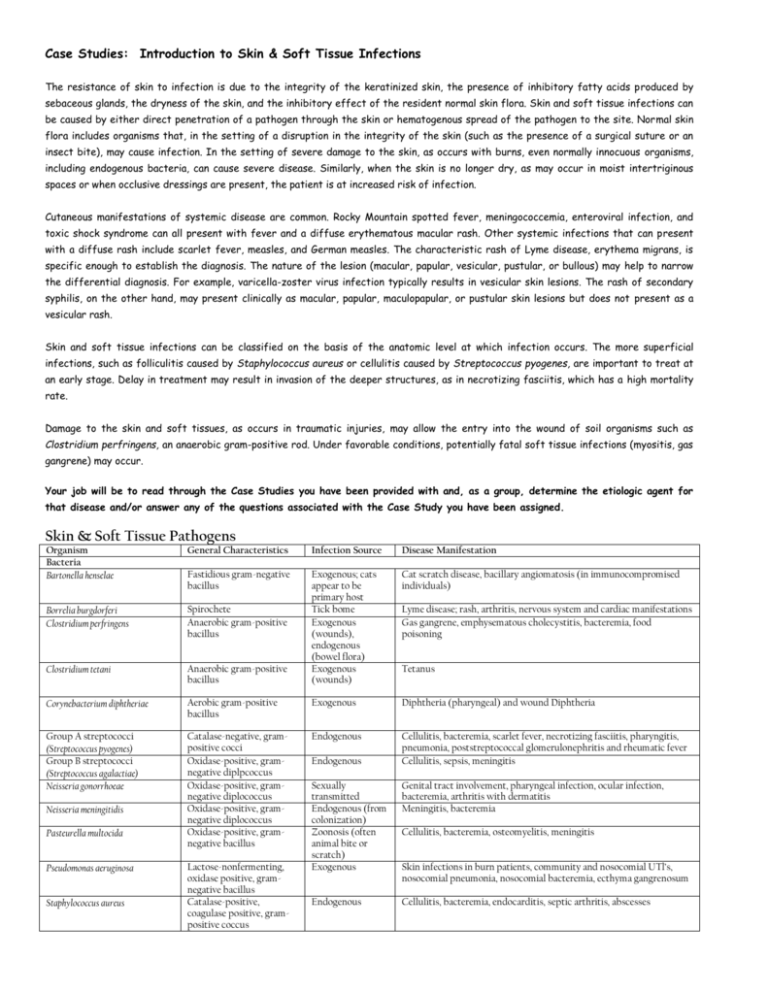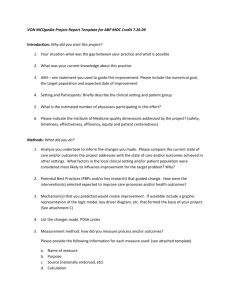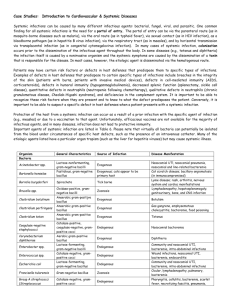The skin
advertisement

Case Studies: Introduction to Skin & Soft Tissue Infections The resistance of skin to infection is due to the integrity of the keratinized skin, the presence of inhibitory fatty acids produced by sebaceous glands, the dryness of the skin, and the inhibitory effect of the resident normal skin flora. Skin and soft tissue infections can be caused by either direct penetration of a pathogen through the skin or hematogenous spread of the pathogen to the site. Normal skin flora includes organisms that, in the setting of a disruption in the integrity of the skin (such as the presence of a surgical suture or an insect bite), may cause infection. In the setting of severe damage to the skin, as occurs with burns, even normally innocuous organisms, including endogenous bacteria, can cause severe disease. Similarly, when the skin is no longer dry, as may occur in moist intertriginous spaces or when occlusive dressings are present, the patient is at increased risk of infection. Cutaneous manifestations of systemic disease are common. Rocky Mountain spotted fever, meningococcemia, enteroviral infection, and toxic shock syndrome can all present with fever and a diffuse erythematous macular rash. Other systemic infections that can present with a diffuse rash include scarlet fever, measles, and German measles. The characteristic rash of Lyme disease, erythema migrans, is specific enough to establish the diagnosis. The nature of the lesion (macular, papular, vesicular, pustular, or bullous) may help to narrow the differential diagnosis. For example, varicella-zoster virus infection typically results in vesicular skin lesions. The rash of secondary syphilis, on the other hand, may present clinically as macular, papular, maculopapular, or pustular skin lesions but does not present as a vesicular rash. Skin and soft tissue infections can be classified on the basis of the anatomic level at which infection occurs. The more superficial infections, such as folliculitis caused by Staphylococcus aureus or cellulitis caused by Streptococcus pyogenes, are important to treat at an early stage. Delay in treatment may result in invasion of the deeper structures, as in necrotizing fasciitis, which has a high mortality rate. Damage to the skin and soft tissues, as occurs in traumatic injuries, may allow the entry into the wound of soil organisms such as Clostridium perfringens, an anaerobic gram-positive rod. Under favorable conditions, potentially fatal soft tissue infections (myositis, gas gangrene) may occur. Your job will be to read through the Case Studies you have been provided with and, as a group, determine the etiologic agent for that disease and/or answer any of the questions associated with the Case Study you have been assigned. Skin & Soft Tissue Pathogens Organism Bacteria Bartonella henselae General Characteristics Infection Source Disease Manifestation Fastidious gram-negative bacillus Cat scratch disease, bacillary angiomatosis (in immunocompromised individuals) Borrelia burgdorferi Clostridium perfringens Spirochete Anaerobic gram-positive bacillus Clostridium tetani Anaerobic gram-positive bacillus Exogenous; cats appear to be primary host Tick bome Exogenous (wounds), endogenous (bowel flora) Exogenous (wounds) Corynebacterium diphtheriae Aerobic gram-positive bacillus Exogenous Diphtheria (pharyngeal) and wound Diphtheria Group A streptococci (Streptococcus pyogenes) Group B streptococci (Streptococcus agalactiae) Neisseria gonorrhoeae Catalase-negative, grampositive cocci Oxidase-positive, gramnegative diplpcoccus Oxidase-positive, gramnegative diplococcus Oxidase-positive, gramnegative diplococcus Oxidase-positive, gramnegative bacillus Endogenous Cellulitis, bacteremia, scarlet fever, necrotizing fasciitis, pharyngitis, pneumonia, poststreptococcal glomerulonephritis and rheumatic fever Cellulitis, sepsis, meningitis Neisseria meningitidis Pasteurella multocida Pseudomonas aeruginosa Staphylococcus aureus Lactose-nonfermenting, oxidase positive, gramnegative bacillus Catalase-positive, coagulase positive, grampositive coccus Endogenous Lyme disease; rash, arthritis, nervous system and cardiac manifestations Gas gangrene, emphysematous cholecystitis, bacteremia, food poisoning Tetanus Sexually transmitted Endogenous (from colonization) Zoonosis (often animal bite or scratch) Exogenous Genital tract involvement, pharyngeal infection, ocular infection, bacteremia, arthritis with dermatitis Meningitis, bacteremia Endogenous Cellulitis, bacteremia, endocarditis, septic arthritis, abscesses Cellulitis, bacteremia, osteomyelitis, meningitis Skin infections in burn patients, community and nosocomial UTl’s, nosocomial pneumonia, nosocomial bacteremia, ecthyma gangrenosum Organism Treponema pallidum Fungi Blastomyces dermatitidis Candida albicans Candida spp., non-albicans Cryptococcus neoformans Epidermophyton floccosum Microsporum spp. General Characteristics Spirochete (does not Gram stain) Infection Source Direct sexual contact, vertical (mother to child) Disease Manifestation Primary (painless chancre), secondary (diffuse rash), latent, and late syphilis; can affect any organ Dimorphic mold Yeast, often germ tube positive Yeasts, germ tube negative Exogenous Endogenous Encapsulated yeast KOH-positive skin lesions; clubshaped macroconidia, absent microconidia KOH-positive skin lesions; fluoresces yellow-green under Wood's light Exogenous Anthropophilic Cutaneous infection, pneumonia, meningitis, bone infection Thrush, vaginal yeast infection, diaper rash, esophagitis, nosocomial UTI, nosocomial bloodstream infection Thrush, vaginal yeast infection, nosocomial UTI, nosocomial bloodstream infection Meningitis, pneumonia, bloodstream infection, cellulites Dermatophyte infection of keratinized tissue (rarely nails) Trichophyton spp. KOH-positive skin lesions Parasites Ancylostoma brazi/iense Ancylostoma caninum Leishmania tropica Pediculus spp. Hookworm of dog Hookworm of dog Protozoan Ectoparasite Phthirus pubis Sarcoptes scabei Viruses Erythrovirus B19 Herpes simplex virus Ectoparasite Ectoparasite Human herpesvirus type 6 Human immunodefi. ciency virus (HIV) Enveloped, dsDNA Enveloped RNA retrovirus Rubella virus (German measles) Rubeola virus (measles) Enveloped, ssRNA Papillomavirus Varicella-zoster virus Nonenveloped, dsDNA Enveloped, dsDNA Nonenveloped, ssDNA Enveloped, dsDNA Enveloped, ssRNA Endogenous May be zoophilic (e.g., M. canis), geophilic (e.g., M. gypseum), or anthropophilic (e.g., M. audouinil) May be zoophilic (e.g., T. mentagrophytes) or anthropophilic (e.g., T. schoenleinil) Dermatophyte infection of keratinized tissue (rarely nails) Exogenous Exogenous Exogenous Exogenous (sand fly) Exogenous Exogenous Cutaneous larva migrans Cutaneous larva migrans Ulcerative skin lesions Body lice Person to person Person to person; reactivation of latent infection; during passage of the neonate through the birth canal Person to person Bloodborne and sexual transmission Vertical, mother to child Respiratory spread Person to person Respiratory spread Erythema infectiousum; anemia Genital ulcers; oral, ocular infections; encephalitis; neonatal infection; esophagitis (immunocompromised individuals) Dermatophyte infection of keratinized tissue including nails Crab louse Scabies infestation Exanthem subitum (roseola) AIDS, mononucleosis-like syndrome with rash in primary infection Inapparent or subclinical infection in adults; birth defects in infants Measles; pneumonia, encephalomyelitis, subacute sclerosing panencephalitis Warts Chicken pox; zoster (may disseminate) Case One A 20-year-old college athlete, Ms. G., had arthroscopic knee surgery. Over the next week she noticed mild swelling, increasing pain, and a small amount of redness at the incision site. Within three weeks the incision site had nearly completely healed, but the patient's knee remained swollen and painful. In addition, she was febrile (41.3°C) and had developed vomiting and diarrhea. She came to the emergency department for treatment. Examination revealed a “toxicappearing” young woman who had a sunburnlike rash on her face, mild skin peeling above the eyes, and red eyes and lips (Figure A). Her blood pressure was 70/50 mm Hg, indicating she was hypotensive, and she had elevated white cells in the blood and a significantly reduced number of platelets. Ms. G. was admitted to the intensive care unit for management of her fever and hypotension. Throat, anterior nares, and vaginal cultures were negative for S . a u r e u s and S t r e p t oc oc c u s p y og e n e s , but because the surgical incision site had healed, it was not cultured originally. Over the next day her condition worsened, despite being treated with oxacillin and supportive care (fluid and electrolytes and vasopressors to maintain blood pressure), and she developed gangrenous toes (Figure B). A needle was inserted into the site of the previous knee surgery, and 300 ml of serous fluid was removed that cultured positive (see Gram stain and BA plate (colony at end of arrow) below). The bacterium also was methicillin resistant. The treatment therapy was changed to include vancomycin, rifampin, and intravenous immunoglobulin. Two weeks after recovery the patient's hand showed extensive peeling (Figure C). 1. 2. 3. 4. 5. What is the most likely organism causing the infection? Why is the incision site not highly inflamed? What toxin was the target of the immunoglobulin and how does it result in the patient’s symptoms? What are the properties of the organism that prevented it from being cleared by oxacillin? This species of bacterium was found to have infected five other patients in this same hospital unit. All had undergone surgery over a recent 3-week period. What could be done to determine if these patients were infected with the same or different strains of this bacterium? Case Two This 12-year-old girl was in her normal state of good health when she developed a fever of several days duration. She had no localizing symptoms, except for the development of a large rash on her back (see below). Her history was notable in that she lived in Connecticut near the New York State border and had recently been walking through tall grass where her sister was taking horseback riding lessons. 1. 2. 3. 4. 5. With what organism was she infected? What disease did she have? What in her history is suggestive of this disease? How is this disease transmitted? How, in the absence of a characteristic rash, is the diagnosis of this disease established? She was appropriately treated with antibiotics and did well. What complications can occur in patients with this disease, particularly those in whom there is no treatment or inadequate therapy? What efforts can be taken to prevent this illness? Case Three A 57-year-old woman with type II diabetes mellitus, Mrs. S. came to the emergency department slightly feverish after 2 days of pain in her right forefoot. When the pain started, she had noted tenderness and serous (watery) discharge between her third and fourth toes. She had been bothered before by an ulcer on the sole of her foot, apparently caused by constant scraping against her shoe. On physical examination she appeared ill and had a temperature of 39.8°C. Her right foot was swollen with patchy erythema, cyanosis, and signs of necrosis. Crusting and oozing was evident around her third and fourth toes. Cultures of the exudate and blood were obtained, and Mrs. S. was treated with antibiotics. After 24 hours she showed no clinical improvement, and the infection continued to ascend proximally. She was taken to the operating room, and multiple incisions revealed necrotic fasciitis extending to the upper thigh. As much of the necrotic tissue was removed as possible. Cultures from the wound grew the organism cultured below. Her blood cultures were negative. Mrs. S. slowly recovered and underwent a second operation for closure of her wound. 1. How does diabetes mellitus predispose to the development of skin infections? 2. What is the name of the pathogen that caused the necrotizing fasciitis? 2. What characteristics of the pathogen enabled it to invade tissues and cause massive damage? 3. Would antibiotics alone have been sufficient in eradicating this infection? Case Four The patient is a 10 year old female, active in dance classes. She is referred to rheumatology at UPMC following a week-long bout of malaise accompanied in the last several days by a pruritic lacy rash on her trunks and limbs (Figure 1). An anti-nuclear antibody (ANA) assay obtained by the outside physician at an outside laboratory was positive to a titer of 1:1,280. On presentation at the rheumatology clinic, the pruritic lacy rash is again evident on the trunks and limbs. No photosensitivity or any appearance of a malar-type rash is appreciated. The patient is afebrile and reports no significant constitutional symptoms. On physical examination, the oropharynx is normal and no splenomegaly is appreciated. She provides additional history of exposure to parvovirus and Epstein Barr virus in dance class prior to the onset of her recent illness. There is no family history of rheumatologic disease. Believing this condition to represent infectious disease versus early rheumatologic disorder (given the high-titer positive ANA), additional laboratory studies were obtained. C-reactive protein, complement protein C3, and immunoglobulin subtype quantities were within normal limits. Complement protein C4 was below detectable limits. Specific antibody testing for anti-double stranded DNA, anti-centromere, rheumatoid factor, Epstein Barr virus nuclear antigen IgG, Epstein Barr virus capsid antigen IgG and IgM were all negative. Anti-parvovirus IgG is negative; however, anti-parvovirus IgM is positive at 6.6 mg/dL. Figure 1 1. 2. 3. 3. What specific species is causing the symptoms? What is the most likely disease? What were the critical factors for your diagnosis? How would you treat this disease and what is the prognosis?





